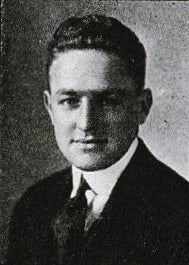- Second Lieutenant
- WW I
Biography
Harold “Pal” Quentin Moore was born in Worcester, Massachusetts and grew up in Westerly, Rhode Island. He was the oldest of three children of Mr. and Mrs. George F. Moore. He was a 1914 graduate of Westerly High School where he was one of the more active members of his class. He was a member of the football team for four years and captain during his senior year. He played baseball and track for two years. He was the Secretary of the Athletic Association, Vice President of his junior class and Athletic Editor of the yearbook. Additionally, he was on the senior play committee and took the part of Sir Charles in “She Stoops to Conquer.”
Pal entered Rhode Island State College in September 1914 with the class of 1918, majoring in Mechanical Engineering. He was Class President during his Junior Year as well as a member of Rho Iota Kappa fraternity, the Football Team and the Glee Club. He participated in the Army ROTC program for three years. When the United States entered World War I, there were 562 male students enrolled at Rhode Island State College; 334 left to serve in WW I. Pal Moore, like so many of his classmates, left college at the beginning of his senior year to enter the U.S. Army and began his officer training at Plattsburg, New York in September 1917. In January 1918, he received his commission as a Second Lieutenant of Infantry and immediately deployed to France.
2LT Moore was initially assigned as an infantry platoon leader, Company F, 1st Battalion, 38th Infantry Regiment, 3rd Division. He was involved in combat operations throughout his assignment. During the period 15-16 July 1918, he led attacks against the enemy positions; and he fearlessly exposed himself to heavy fire as he led his soldiers to vigorously engage the enemy. During this period, he was wounded by shrapnel and gassed. His Victory Ribbon has Five Gold Stars; each Gold Star represents one battle campaign. The most an individual could have earned is seven. Realistically, anything above three battle campaigns is an outstanding accomplishment by World War I standards.
On 31 December 1918, the Commander of the American Expeditionary Forces cited First Lieutenant Harold Q. Moore, U.S. Army for Gallantry in Action and Bravery. He was recommended for the Distinguished Service Cross and awarded the Citation Star.
Citation Star
For “Gallantry in Action,” by direction of the President, under the provisions of the act of Congress approved 9 July 1918, First Lieutenant Harold Q. Moore is awarded the Citation Star. During the entire day of 15 July 1918, Lieutenant Moore, 2nd Battalion, 38th Infantry Regiment, 3rd Division, American Expeditionary Forces repeatedly showed the greatest personal bravery by continually exposing himself to a murderous artillery bombardment to keep in working order the liaison between infantry companies on the front lines and units on the flanks. Several times during the same day, under severe artillery bombardment, he collected stragglers and messengers, organized them and put them in the front line. On the morning of 16 July 1918, Lieutenant Moore volunteered to take a combat patrol to Moulins. Though the town was under heavy artillery bombardment, he conducted the patrol through the town and vicinity, rescuing wounded men and getting them to first aid stations. In continually performing duties that were not expected of him, in volunteering for and executing most hazardous tasks, all of them under terrific artillery and machine gun fire, Lieutenant Moore performed acts of conspicuous bravery and gallantry in action, an unusual devotion to duty and set a high standard for the men of the battalion.
The Silver Star Medal was not established until 1932. At that time, Veterans of World War l who had been cited for “Gallantry in Action” where awarded the Silver Star Medal in lieu of the “Citation Star.”
After World War I, Harold Moore returned to the United States and settled in Stonington, Connecticut. He married his wife Dorothy, and they had three children. Harold was the President of the George C. Moore Company in Westerly, Rhode Island for 30 years. Harold volunteered his time and energy in support of higher education as a member of the Board of Trustees of State Colleges.
Harold Moore died on 27 December 1963 and was buried with full military honors at River Bend Cemetery, Westerly, Rhode Island. Second Lieutenant Harold Quentin Moore, Infantry, U.S. Army was a son of Rhode Island State College who answered the call to service for Rhode Island and America during World War I. He is a true American hero.
Education
1918

